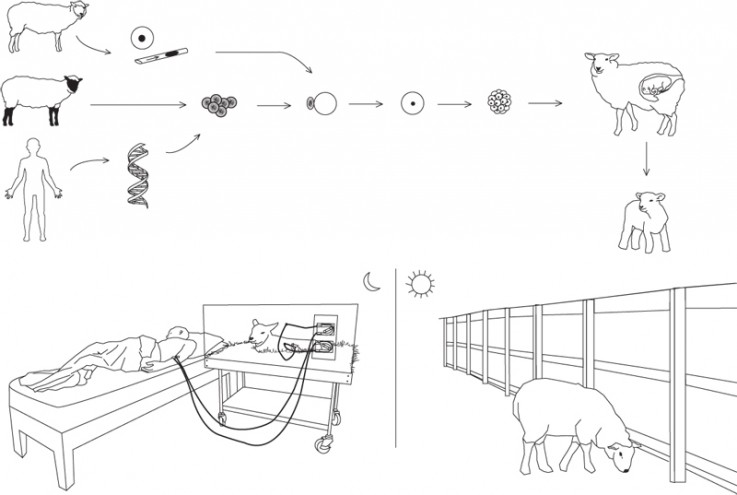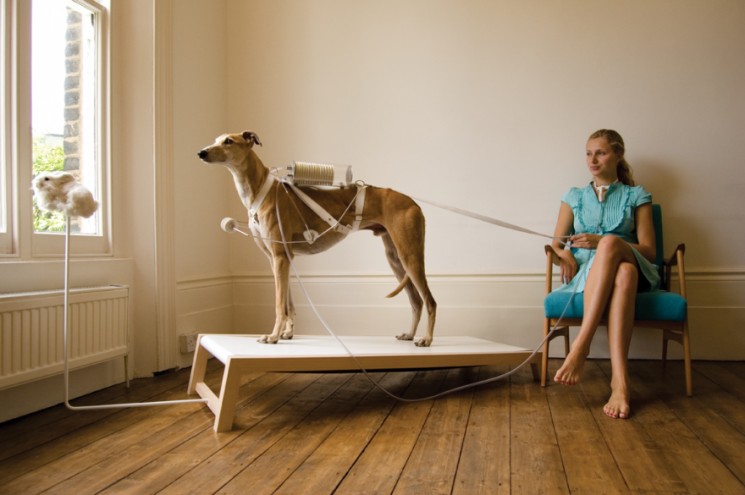Part of the Project
First Published in
“As Gregor Samsa awoke one morning from uneasy dreams he found himself transformed in his bed into a gigantic vermin,” reads the opening sentence of Franz Kafka’s 1915 novella, Metamorphosis. Often interpreted as an indictment on so-called human “progress” and “evolution”, Kafka portrays the giant insect as the most human in thoughts and feelings, while the family’s loyalty and empathy is constantly tested.
Designer and researcher Revital Cohen’s work proposes that technologies like bioengineering and nanotechnology could result in a radical human metamorphosis. Juxtaposing the natural with the artificial, she goes beyond the aesthetic potential of biological enhancement, instead raising disarming questions about human values, ethics and behaviours. “As a species that can design its own evolution, there are just so many questions to ask,” she points out.
Having graduated from the Royal College of Arts as top student just more than a year ago, Cohen’s work spans various mediums and includes collaborations with scientists, bio-ethicists, animal breeders and the UK’s National Health Service (NHS). As a research associate within the Design Interactions department at the Royal College of Art, she is currently working on a speculative project investigating genetics and nanoparticles, supported by a Wellcome Trust Art Award.
Design Indaba turns the tables on this probing designer, asking her the questions.
Last year you graduated from the Royal College of Arts as top student in the Masters Design Interactions programme. How did you come to enrol in the course – what did you do before?
Before enrolling I studied furniture design and spent a year doing internships and working on a few freelance projects. However, while I was studying and working as a furniture designer, the constraints imposed by production limitations and market value frustrated me. I have always been more interested in the hidden meaning of objects, the stories they tell and their unintended functions. I was inspired by the head of department Anthony Dunne and partner Fiona Raby’s approach to design and admired the freedom they were giving their students.
As I was always fascinated with “wet” materials and design in relation to the human body, medicine, augmentation, body hacking and animals, I was really drawn to the new direction the course was taking at the time. It was opening the door for designers to start thinking about the implications of emerging technologies.
Your products and furniture seem fundamentally pinned on how humans interact with other humans. How do you approach design to influence interaction?
Every object is a result of an observation or interpretation of existing human interactions. I find it very hard to design without referencing people’s behaviour, or to invent an interaction out of thin air. My approach is mostly based on attempting to evoke a response by provoking a mental association. I always base my designs on little things I notice and big things I read – I think that is what makes extreme ideas realistic, understandable and relatable.
Human habits that we’re not proud of – anger, smoking, paranoia, clutter, mood swings, etc – are often highlighted in your work. Does your work aim to validate or change these qualities?
I think design becomes meaningful when it is honest. Real people actually often behave in ways that are contradictory, self-destructive or temperamental. I would rather surround myself with objects that understand and accept me with all of my human faults, than try and live up to the imaginary glossy lifestyle that a slick product enforces.
You have a particularly unique take on challenging biological limitations, not only in terms of aesthetics, but function. Where does this stem from?
The essence, magic and power of design – to rethink, reinvent and create function – is what I find the most fascinating. In this age where the body and its functions can actually be designed, I think it is time to explore this space and not in the medical or cosmetic context.
I am really intrigued by what might happen as our biology becomes controlled and adjustable. In a way, all these scientific advancements and emerging technologies challenge our perceptions of matter; our bodies can be moulded, manipulated and juxtaposed with other materials, and we suddenly take many confusing, questionable roles. Since design is occupied with manipulating materials as well as behaviours and social structures, I think that by applying design thinking to imagine the implications of biotechnology, we can explore the human condition, present and future.
If you think about it, today’s medical technologies are already challenging biological functions. To me the idea of the cyborg as an organism that has both natural and artificial systems can easily be applied to most of us, with our use of behavioural drugs, hormones or medical prostheses. I think there is an interesting dissonance with us controlling technology that in turn transforms us into something else. I guess we are always a little bit of the creature as well as the creator. As a species that can design its own evolution, there are just so many questions to ask.
My work focuses mostly on the emerging technologies as I consider life sciences to be a really powerful catalyst for design. These novel possibilities present us with new sets of values, ethics and behaviours. By researching the potential implications of biotechnology, I am constantly forced to rethink everything I believe to know. Biotechnology and the possibilities it entails (actual as well as hypothetical) motivate me to reassemble my worldview. I hope to evoke a similar process of reflection and reassessment by making these questions physical.
The Artificial Biological Clock addresses modern irregularities in the female reproductive cycle due to artificial light, contraceptive hormones and societal pressures such as career. What are your views on feminism?
I am not sure that my views are relevant. I think one of the most important aspects of my work is that it does not carry a distinct message or promote an agenda. I would like to think that my work leaves many questions unanswered, provoking debate or reflection where the viewer makes their own opinion. I am often drawn to work with issues to which I have no answer myself, or to which there are no definite rights or wrongs, just a big grey of contradictions.
Life Support repurposes animals to provide external organ replacement, simultaneously providing patients with companions. This revision of natural symbiosis can either endear viewers or make them squeamish. Is the project a real possibility or a provocation?
The project is speculative but based on reality. Technically I guess it could be realised but that was not my intention. I would say the project functions as a design provocation aimed at triggering a debate concerning bioethical issues and offering critique on the inhumane nature of medical technologies. There is a space for design that is not just focused on utilitarian functionality, especially when looking into evolving technologies. In my opinion, design in this experimental form can really creep into peoples’ understanding of reality and challenge it by being familiar but speculative at the same time.
All of your work, including your Electrocyte Appendix for Design Indaba’s Protofarm 2050 project, is underpinned by thorough research and scientific consultation. Can you describe your design process?
An erratic and non-linear combination of research, observation, speculation, harassment of scientists with odd questions and a construction of a narrative from it all! I tend to delve into a lot of scientific research that I really don’t understand, looking for unexpected connections to get myself intrigued, excited and inspired. Cultural interpretations of science fascinate me and I am inspired by my own misinterpretation of it.
This juxtaposition of ignorance, curiosity and imagination gets me started. Once I have focused my concept, I do study the science thoroughly though and I would scrap it all if I got it completely technically wrong. The design stages themselves are pretty standard – drawings, mock ups, technical problems... I still very much believe that form should follow function, it is just that complex functions require a depth and context to the story to get all the details right.















